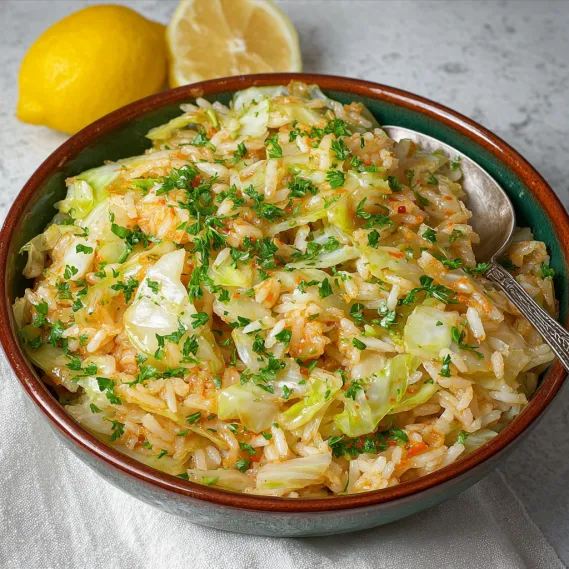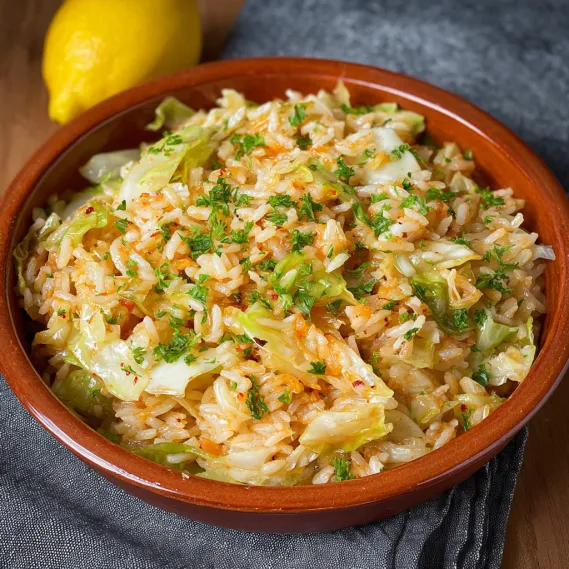 Pin
Pin
This humble Greek rice and cabbage dish transforms basic ingredients into a comforting meal that warms both body and soul. Lahanorizo has been my cold-weather salvation ever since I discovered authentic Greek cooking, with its simple yet profound flavors that prove good food doesn't need to be complicated.
I first made this during a particularly tight grocery budget month, and it's since become one of my most requested comfort foods. The way the cabbage melts into silky strands while the rice soaks up all those aromatic flavors creates something far greater than its humble parts.
Ingredients
- Olive oil: brings authentic Mediterranean flavor and richness to the dish
- Onion carrot and leek: create the aromatic flavor base essential for depth
- Fresh garlic: adds necessary punch that dried simply cannot match
- Tomato paste: concentrates umami and adds subtle color to the dish
- Cabbage: becomes remarkably sweet and tender when properly cooked
- Round grain rice: absorbs flavors while maintaining pleasant texture
- Vegetable stock: infuses every grain with savory goodness
- Fresh dill: provides distinctive Greek flavor profile and bright color
- Lemon juice: adds essential brightness that balances the dish perfectly
- Salt and pepper: enhance all other flavors when added thoughtfully
Step-by-Step Instructions
- Create the Flavor Base:
- Heat olive oil in your Dutch oven over medium heat until it shimmers but doesn't smoke. Add onion carrot and leek together stirring occasionally for a full 5-6 minutes. This patient cooking develops sweetness and creates the foundation for the entire dish. Watch for the onions to become translucent and slightly golden at the edges.
- Build Aromatic Depth:
- Add minced garlic to the softened vegetables and stir constantly for 1-2 minutes until you can smell its fragrance wafting up from the pot. Be vigilant here as garlic burns quickly and becomes bitter. Once fragrant stir in tomato paste cooking for another full minute while coating all vegetables. This brief caramelization transforms the tomato paste from sharp to complex.
- Transform the Cabbage:
- Add all your sliced cabbage to the pot which will look overwhelming at first but quickly cook down. Season generously with salt which helps extract moisture and begin the wilting process. Sauté for a full 8-10 minutes stirring occasionally until the cabbage reduces significantly in volume and becomes soft and glossy.
- Create the Rice Base:
- Stir unrinsed rice directly into the vegetable mixture coating each grain with flavor. Pour in your vegetable stock and bring everything to a gentle boil. Reduce heat immediately to maintain a steady simmer and cover partially with a lid. Cook for 15-20 minutes checking occasionally to ensure there's enough liquid. The rice should be tender but still have slight resistance when bitten.
- Finish with Fresh Elements:
- Remove pot from heat completely before stirring in the chopped dill and fresh lemon juice. These heat-sensitive ingredients provide brightness and lift when added at the end. Taste carefully for seasoning adding more salt pepper or lemon juice as needed until the flavors sing harmoniously.

My grandmother always insisted on using the freshest dill possible in this dish explaining that herbs were the soul of Greek cooking. I remember watching her taste and adjust almost like conducting an orchestra until everything was perfectly balanced. That attention to seasoning is what elevates this simple peasant dish to something truly memorable.
Storage and Reheating
Lahanorizo keeps exceptionally well in the refrigerator for up to four days in an airtight container. The flavors actually intensify overnight making leftovers sometimes better than the original serving. When reheating add a small splash of water or stock to loosen the rice which tends to absorb liquid as it sits. Gentle stovetop reheating works best but microwave is perfectly acceptable for quick lunches.
Authentic Variations
Throughout different regions of Greece you'll find subtle variations on this classic dish. Some coastal areas add dried Greek oregano instead of dill while others include small amounts of cinnamon for warmth. In northern regions you might find chopped preserved lemon peel added for extra brightness or pine nuts for texture. My favorite variation includes a handful of chopped kalamata olives stirred in just before serving for a briny counterpoint to the sweetness of the cooked vegetables.
Serving Suggestions
While perfectly satisfying on its own lahanorizo truly shines when accompanied by traditional Greek companions. Serve alongside thick Greek yogurt drizzled with honey and toasted walnuts for a complete protein-rich meal. For special occasions pair with simple grilled fish dressed with nothing more than lemon olive oil and oregano. During summer months accompany with a fresh tomato cucumber and feta salad dressed with red wine vinegar.
Common Questions About This Recipe
- → What type of rice works best in lahanorizo?
Round grain rice, such as Arborio, is preferred as it absorbs flavors well and creates a creamy texture suited for lahanorizo.
- → How do I prevent the rice from sticking or becoming mushy?
Keep an eye on the simmer and add extra stock if needed. Stir occasionally and cook just until the rice is tender but not overdone.
- → Can lahanorizo be made ahead of time?
Yes, it keeps well in the fridge for up to two days. Reheat gently on the stove, adding a splash of stock or water to restore texture.
- → Are there variations for added flavor or nutrition?
Extra vegetables like celery or green peas can be added. Fresh dill or parsley boosts the herb flavor further.
- → How is lahanorizo typically served?
Serve it warm, finished with extra virgin olive oil, lemon wedges, and plenty of cracked black pepper for the authentic Greek touch.
